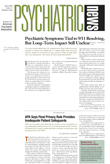For some time now, a race has been on to do something that has never been possible in living Alzheimer’s patients: to find a compound that could get from their bodies into their brains, adhere to amyloid plaques in their brains, and, when radioactively labeled and used in conjunction with PET scans, make the amyloid visible. Two such compounds now seem to have been found.
The first compound, called FDDNP, was discovered by Jorge Barrio, Ph.D., a professor of molecular and medical pharmacology at the University of California at Los Angeles (UCLA) School of Medicine. It was applied in conjunction with PET scans to nine Alzheimer’s patients and seven control subjects by Gary Small, M.D., a professor of psychiatry, aging, and biobehavioral sciences at the UCLA School of Medicine, along with his colleagues. As the team reported in the February American Journal of Geriatric Psychiatry, the compound stayed in areas of the Alzheimer’s patients’ brains that are known from autopsy studies on deceased Alzheimer’s patients usually to contain amyloid deposits for a much longer time than in control subjects’ brains.
And because the probe stayed in the pertinent brain areas much longer in the Alzheimer’s patients than in the controls, it was probably adhering to amyloid in these regions, Small explained to Psychiatric News. In addition, since it stayed in those brain regions much longer in Alzheimer’s patients than in controls, it also meant that one could see those brain regions in the former, but not in the latter. “We also have autopsy confirmation of our results in a patient who received FDDNP-PET and subsequently died,” Small said.
The second compound, called the Pittsburgh compound, was developed by William Klunk, M.D., Ph.D., an associate professor of psychiatry at the University of Pittsburgh. Klunk and Chester Mathis, Ph.D., a professor of radiology at the University of Pittsburgh, collaborated with Swedish scientists to see whether the compound, in conjunction with PET scans, might visualize amyloid in the brains of Alzheimer’s patients. The major Swedish scientists who were involved in the experiment were Bengt Långström, Ph.D., director of the University of Uppsala PET center; Henry Engler, M.D., medical director of that PET center; and Agneta Nordberg, M.D., Ph.D., a professor of clinical neuroscience at the Karolinska Institute in Stockholm.
The team applied the Pittsburgh compound, in conjunction with PET scans, to nine Alzheimer’s patients and five cognitively normal subjects. And as they reported at the international Alzheimer’s conference in Stockholm in July, the compound visualized areas of the Alzheimer’s patients’ brains that, from autopsy studies on deceased Alzheimer’s patients, are known to usually contain amyloid, but did not visualize areas of the patients’ brains that are known to be bereft of amyloid. In the control subjects, the compound visualized no brain areas except a bit of white matter.
Commenting on the efforts by Klunk and his team, Small said, “We have seen very limited human study results from the Pittsburgh group. Also, their approach uses a very short-lived [half of it disappears within 20 minutes] radioactive label, making it impractical for clinical use.”
Psychiatric News also asked Klunk what he thought of the efforts by Small and colleagues, to which he replied: “I think the field in general feels that there is a huge amount of nonspecific binding for [FDDNP].”
Steven DeKosky, M.D., director of the University of Pittsburgh’s Alzheimer’s Disease Research Center, told Psychiatric News that he thought that the Pittsburgh compound is probably a bit better “because it stains where it is supposed to and does not light up where it is not supposed to.”
But the more important point, DeKosky emphasized, is that research efforts by both groups show “that we are going to be able to noninvasively image amyloid in people with Alzheimer’s. . . .For a while we weren’t sure we would be able to do it, but it now clearly looks like it is going to work.”
While such imaging might eventually be used to diagnose Alzheimer’s in its very early stages, he pointed out, its more immediate value will probably be assessing the effectiveness of experimental drugs that are supposed to decrease amyloid in the brain or slow down its accumulation. “We need a way to tell that noninvasively,” he said.
An abstract of “Localization of Neurofibrillary Tangles and Beta-Amyloid Plaques in the Brains of Living Patients With Alzheimer’s Disease” is posted on the Web at http://ajgp.psychiatryonline.org/cgi/content/abstract/10/1/24?. “First Human Study With a Benzothazole Amyloid-Imaging Agent in Alzheimer’s Disease and Control Subjects” is posted at www.congrex.com/scripts/cainii/cainabstract.asp?Conf_Id='02070203'&Serial_Number=4731. ▪
Am J Geriatr Psychiatry 2002 10 24
